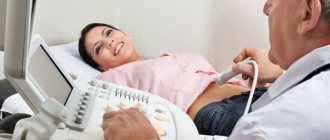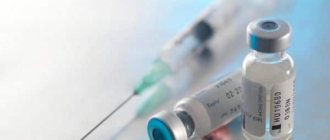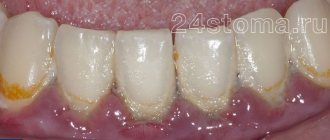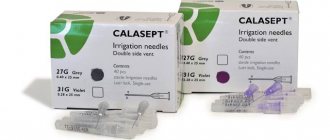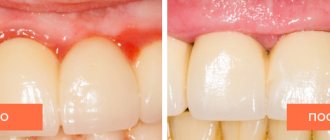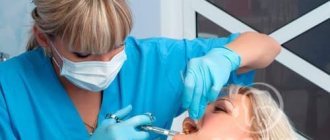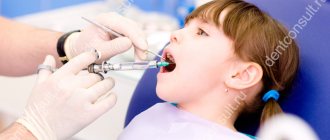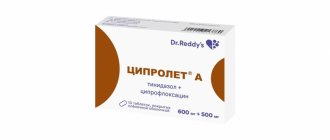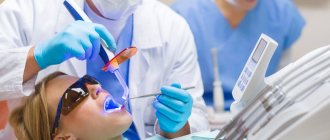- Symptoms of acute pulpitis
- Causes
- Diagnostics
- Treatment of acute pulpitis
- Complications in the treatment of acute pulpitis
Acute pulpitis is an inflammatory reaction of the dental pulp in response to infection or the action of any irritants.
It is characterized by short or prolonged attacks of toothache, which becomes more severe at night and occurs when exposed to cold and hot. The disease is identified based on patient complaints, examination of the oral cavity by a dentist, by radiography and electroodontodiagnosis. If acute pulpitis is diagnosed, treatment is carried out in two ways - conservative or surgical.
Symptoms of acute pulpitis
As the disease develops, aching pain in the tooth first appears, which has an increasing character. The pain syndrome is constant or intermittent, significantly intensifies at night and with temperature influences. A diseased tooth reacts most strongly to cold. If you knock on the surface, the patient does not have any unpleasant sensations or they are insignificant.
The manifestations of symptoms of acute pulpitis depend on its form.
Hyperemia
It develops as a result of the activity of pathogenic bacteria that enter the dental tissue during untreated caries. It can occur during tooth preparation or after it has been treated with chemicals.
With hyperemia, the patient is concerned about the following symptoms:
- It's a dull pain. Occurs as a reaction to stimuli. Mostly, the painful attack does not last long, about 2 – 3 minutes, and at night lingering pain develops. In the case of an advanced form, the pain is felt as sharp and strong lumbago.
- Severe pain reaction when enamel is exposed to cold.
Acute focal
Signs that indicate the development of this form of pulpitis:
- Painful attacks occur spontaneously.
- They last for at least 30 minutes; in advanced stages they can last up to two hours.
- A carious cavity is revealed, which is painful during examination.
In acute focal pulpitis, the pain does not radiate to adjacent teeth.
Acute diffuse
It develops as a consequence of an advanced focal form and the lack of timely treatment.
Characterized by the following symptoms:
- The pain syndrome occurs spontaneously and suddenly, without exposure to any irritants. The pain is prolonged, does not go away for many hours, and radiates to nearby teeth.
- The presence of a carious cavity, when examined, a sharp painful reaction occurs. Remnants of filling material may remain.
Acute purulent
If the acute diffuse form is not treated, it gradually turns into a purulent form. Characteristic symptoms:
- The pain attack is cutting, acute in nature. The pain is constant and may periodically weaken or intensify.
- The pain radiates to neighboring teeth, as well as along the branches of the trigeminal nerve.
- When exposed to heat, the pain becomes stronger; when applying a cold compress, it subsides a little.
- Pus accumulates in the tooth cavity and can be detected by microscopic examination.
- The soft tissues melt and abscesses with pus form in them.
- The blood vessels are dilated and have many microdamages.
Traumatic acute
Develops as a result of tooth injury due to improper preparation of a carious cavity, chipping of a dental crown or fracture.
This form of pulpitis is characterized by the following symptoms:
- The pulp horn bleeds, which is noticeable during a dental examination.
- The dental cavity communicates pointwise with the carious cavity.
- In the pulp tissues, a bundle of vessels and nerves is exposed.
If there are signs indicating acute pulpitis of the tooth, treatment should not be delayed. A timely visit to the clinic will help save the tooth.
Smoking and tooth extraction
The question of how safe it is to smoke after tooth extraction worries many smokers. The procedure itself is associated with a certain amount of stress, and therefore many patients involuntarily have the urge to smoke a cigarette after visiting the dentist’s office. It is believed that this way you can get a certain calming effect. However, it is still better to refrain from this ritual, because nicotine and tar can have an irritating effect on an open wound. Otherwise, there is a risk of bleeding and pain. In addition, tobacco smoke slows down the healing process.
Important! After wisdom tooth removal, all precautions must be observed especially strictly. Often, such an operation is complicated by an overly branched and tangled root system, which the doctor is forced to remove in stages. If you smoke, be sure to tell your dentist this, and at the same time clarify how long after removal you can smoke a cigarette.
The patient will have to be patient and wait at least 2 hours after the procedure. It is important to wait until the bleeding stops completely. Another unpleasant consequence can be the so-called dry socket, while the presence of a protective blood clot in it is an extremely important condition for preventing wound infection.
Causes
The reasons for the development of pathology may be the following:
- Tooth injury, mechanical or chemical. Violation of the integrity of enamel and dentin makes the pulp extremely vulnerable to the effects of the external environment and pathogenic bacteria.
- Gum diseases. In this case, there is a high risk of infection entering through open periodontal pockets.
- Complications of caries. Uncured caries or its advanced form contribute to the entry of pathogenic microorganisms - streptococci - into the pulp through the dentin tubules.
- Incorrectly performed dental treatment - damage to dental tissue, opening of a tooth performed in violation of technique, burn of dental tissue by arsenic, etc.
- Incomplete removal of carious tissue during treatment. The infection persists in the dental cavity and continues to develop.
- Poor quality filling installation. It is dangerous because there is a gap between the tooth wall and the filling material. Through it, pathogenic microorganisms penetrate into the pulp.
How is inflammation of the trigeminal nerve treated?
Correct treatment for inflammation of the trigeminal nerve can only be prescribed by a neurologist. Depending on the complexity of inflammation, the following agents are included in therapy:
- Drugs to combat symptoms (pain);
- Antispasmodics and muscle relaxants of central action;
- Alcohol blockades (for severe inflammation);
- Metabolic drugs;
- Anticonvulsants (carbamazepine, finlepsin);
- B vitamins;
- Physiotherapeutic procedures.
The measures are aimed at relieving inflammation and completely eliminating pain symptoms. Properly prescribed treatment for inflammation of the trigeminal nerve can not only restore excellent health, but also prevent relapses.
This information is for informational purposes only. Only a professional specialist can prescribe treatment after examination and diagnosis.
Diagnostics
Diagnosis of pulpitis takes place in several stages. The first is an examination of the oral cavity by a dentist. The patient's complaints about acute pain, the presence of injury or a carious cavity are taken into account. All this points to pulpitis. But it is impossible to determine the acute and chronic forms of the disease by one visual examination.
To determine the stage and type of pathology, the patient is prescribed an examination:
- X-ray.
- EDI or electroodontodiagnosis. This method allows us to identify the reaction of the pulp to the influence of electric current.
- Rheodentography. It is carried out to assess the blood supply to the dental pulp.
- Thermal test.
To make an accurate diagnosis, differential diagnosis of acute pulpitis is important. This is important so as not to confuse it with other diseases that have similar manifestations.
Smoking and implantation
Unfortunately, such concepts as smoking and dental implants are practically incompatible. Patients who smoke are much more likely to experience implant failure , especially if they smoke during osseointegration.
Smoking several months before the procedure is no less harmful. Much the same can be said about prosthetics – it is much more difficult for smoking patients to adapt to wearing prostheses, and they often experience complications and side effects.
IMPORTANT: Unfortunately, concepts such as smoking and dental implants are practically incompatible. Patients who smoke are much more likely to experience implant failure, especially if they smoke during osseointegration.
Treatment of acute pulpitis
Treatment goals:
- stop a pain attack;
- eliminate inflammation and stop the infectious process;
- restore the anatomical shape of the tooth.
When dealing with acute pain, the patient is prescribed painkillers to reduce pain until the dental appointment.
The disease is treated in two main ways - conservative or biological and surgical. In both, therapy is carried out with preliminary anesthesia. The injection is given approximately 30 minutes before the start of treatment. For anesthesia, a solution of lidocaine or trimecaine is most often used.
Conservative method of treating acute pulpitis
The main goal is pulp preservation. The doctor conducts step-by-step treatment:
- gives an injection for pain relief;
- removes necrotic dentin;
- opens the tooth cavity;
- treats with antimicrobial agents;
- lays down medicine;
- puts a filling.
Conservative therapy is carried out mainly in young patients. This method requires mandatory consideration of the presence of diseases of the oral mucosa, as well as the localization of caries.
During treatment, anti-inflammatory drugs are used - Calcidont, Dical. Preparations containing calcium hydroxide are necessary to stimulate dentin formation. Proteolytic enzymes are necessary for tissue regeneration and swelling removal. After placing the medicine, the dentist closes the tooth cavity for several days - from 3 to 5. Next, if there is no reaction of the pulp, a permanent filling is placed.
Operative or surgical method
The doctor carries out the following stages of treatment:
- Provides first aid for acute pain.
- Gives an injection for pain relief.
- Opens the dental cavity.
- Removes pulp.
- Treats the cavity with an antiseptic.
- Puts in medicine.
- Installs a seal.
This method is used to treat acute diffuse pulpitis. If acute focal pulpitis is diagnosed, treatment involves removing the ostial and coronal pulp, while preserving the root pulp.
Surgical treatment is carried out in one or two visits.
For surgical treatment in one visit, the order is as follows:
- The doctor administers anesthesia and removes necrotic tissue.
- Using instruments, the tooth is filled with a non-toxic material.
When undergoing surgical treatment in two rooms, the procedure has a different procedure:
- First, the dentist applies arsenic or a devitalizing paste containing arsenic to the affected area of the tooth. This is necessary to kill the inflamed nerve. The duration of installation of arsenic on a diseased tooth is 24 hours on a single-root tooth, up to 48 hours on a multi-root tooth. Some types of pastes can be left for a long time - up to 7 - 15 days.
- A tampon with an anesthetic is placed in the canal and a temporary filling is placed. The patient is sent home.
- At the second visit to the dentist, the doctor extracts the arsenic or paste, completely removes the pulp and fills the tooth cavity.
The surgical treatment process is always monitored by radiography.
Alternatives to cigarettes that cause less harm
Thanks to steadily developing technologies, smokers today have a chance to make their addiction less dangerous and protect their oral cavity. For this purpose, various alternative means , for example:
- Electronic cigarettes - in some ways, the principle of operation of an electronic cigarette is similar to an inhaler. This device has a shape similar to the usual cigarettes and creates the illusion that a person is using a regular tobacco product. An electronic cigarette includes a battery, LED indicator, vapor generator, replaceable cartridge and other components.
- Hookah is equipment for smoking hookah mixtures and consists of a shaft, a flask (water is poured into it) and a cup (the smoking mixture is poured into it). Essentially, a person inhales aromatic smoke and thereby satisfies his habit.
- Patches create optimal conditions for the intake of purified nicotine into the body, which helps satisfy the daily need for smoking.
- POD systems are compact electronic cigarettes with a small battery, which are a disposable item. Very convenient to use.
- Sprays are recommended during the period of quitting an addiction; their principle of action is similar to nicotine patches. But in both cases, the nicotine component is used as replacement therapy (to prevent the development of withdrawal syndrome). Suitable for experienced smokers. Sprays are available both nasally and orally.
Sources:
- https://telo.guru/kurenie/vred/izmeneniya/zuby-kurilshhika.html
- https://MikDent.ru/estetika/uhod/kurenie-i-zuby.html
- https://mnogozubov.ru/kurenie-vliyanie-na-zuby/
- https://Denta.help/terapevticheskaya/nekarioznye/zuby-kurilshhika-1313
- https://stom.32top.ru/stat/1877/
- https://dentamed.club/gigiena/profilaktika/zuby-kurilshhika.html
Complications in the treatment of acute pulpitis
In some cases, as a result of treatment of acute pulpitis, the patient develops complications. Severe pain or increased sensitivity occurs when:
- biting hard food, chewing rough food;
- pressing on the tooth;
- exposure to cold water.
In such cases, the doctor prescribes treatment of the tooth with an anesthetic solution or a course of physiotherapy in the form of obtaining fluctuating currents. In case of relapses, it is recommended to replace the medication that was placed in the dental cavity during treatment. If such procedures are not effective, the affected tooth may be removed.
If treatment of acute pulpitis is required, the price depends on a number of factors. The final cost is influenced by the quality of the consumables used, medications, types of material for filling, as well as the equipment used. Dental clinics have a standard price list that indicates how much each procedure costs.
Types of tablets for toothache
There are a lot of medications for teeth. They differ from each other in:
- active substance;
- dosages;
- pharmacological action;
- side effects;
- contraindications.
Each class fights its own “enemy”. Most often, patients in dental clinics are prescribed analgesics. Penetrating into the systemic bloodstream, they minimize stimulation of nerve fibers and prevent the passage of intense pain impulses.
As for antispasmodics, they cannot be called an effective dental pain reliever. Drugs in this group are more suitable for conditions caused by spasm of smooth muscles. They affect the sympathetic nervous system. Relieves discomfort due to disorders of the kidneys, gastrointestinal tract, gynecological pathologies, and migraines. However, with mild pain they can also help.
Many dental clinic clients are prescribed non-steroidal anti-inflammatory drugs (NSAIDs). These are drugs that have antipyretic and anti-inflammatory effects. They quickly stop the spread of inflammatory processes, including in the oral cavity.
What to do next
On the Internet you can find ways to kill the nerve of a tooth at home. To do this, it is recommended to use medical alcohol, iodine, zinc and even gunpowder. However, doctors at the Center for Israeli Dentistry categorically do not recommend resorting to such methods at home. Self-killing the nerve in some cases leads to the following complications:
- Allergic reactions to the drug. In severe cases, the allergy causes respiratory arrest.
- Damage to nearby tissues.
- Burns to mucous membranes when using aggressive agents such as concentrated alcohol or iodine.
- Taste disorder.
- Tooth infection. At home, there is a high risk of infection.
Taking into account the above circumstances, doctors at the Center for Israeli Dentistry strongly recommend that you consult a dentist if you have a toothache. Pain relief is acceptable while waiting for a visit to the doctor. It is important to eliminate the root cause of nerve irritation in the tooth (caries, pulpitis, periodontitis and others). Otherwise, a person risks losing a tooth.
